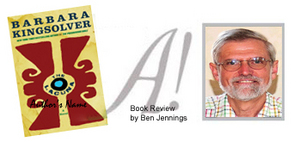

The Lacuna, Barbara Kingsolver's new novel, is her best work!
It's more carefully crafted and a more profound exploration of the American character than The Poisonwood Bible, which most people regard as her masterwork. It's also Kingsolver's most personal novel, even though it is a portrait of a male Mexican-American writer, spanning the 1920s to the 1950s.
This is Kingsolver's first novel since Prodigal Summer in 2000, and you sense that the novel has been developing for nearly a decade. In the aftermath of the 2001 attacks on the World Trade Center, Kingsolver wrote an op-ed piece for the Los Angeles Times in which she stated, "The mortal citizens of a planet are praying right now that we will bear in mind, better than ever before, that no kind of bomb ever built will extinguish hatred." In that period of heightened emotion and patriotic fervor, Kingsolver was widely denounced as unpatriotic and un-American for her stance, and many wished her harm and hoped she would pack up and leave the country. The Lacuna is her response to those critics.
The novel is also another first for Kingsolver. It's a historical novel, where she artfully interweaves fictional characters with famous political and cultural figures of the early 20th-century. The narrative structure of the novel is told in a mixture of diary entries, letters, and newspaper clippings (most real but some fabricated).
The Lacuna is the life story of Harrison William Shepherd, whose mother is Mexican and father is American. The early sections of the novel reflect his early life as an embryo artist on an island off the east coast of Mexico -- his loneliness, his turning inward, and his precocious observational abilities -- as he keeps detailed diary entries of his life.
Actual historical events enter the novel when, as a teenager, he is sent by his father to a prep school outside Washington, D.C., and witnesses the Bonus Marches and the tent cities of the early 1930s. Back in Mexico City, he is befriended by the famous artists Diego Rivera and his wife Frida Kahlo. For many years he works as a plaster mixer for Rivera when he is painting his famous public murals, then as a cook and typist for them and their houseguest Leon Trotsky, who is hiding from Soviet assassins. Shepherd is there when Trotsky is killed.
Returning to the United States, he settles in Asheville, N.C., where his rich knowledge of Mexican culture and history allows him quickly to write historical potboilers about Mexican Aztec and Mayan history, with sensationalized titles like Vassals of Majesty, but the novels are obvious allegories about America's imperial ambitions and actions.
The narrative reaches its dramatic highpoint when Shepherd is called before the House Un-American Activities Committee hearings in the early 1950s for being a subversive and a communist.
The most interesting fictional character besides Shepherd is Violet Brown, a mountain woman who has come to Asheville to escape her rural background and seek awareness of the wider world. They meet in a boarding house and she later becomes his secretary and confidante, helping to keep him grounded with her humanity and tolerance.
The Lacuna is an important novel. Kingsolver has long been fascinated with the unique American psyche and why we are so uneasy with national self-criticism. In this novel she explores how that may have dated back to the 1950s, during what we call the McCarthy era, when dissident writers and artists were fiercely censored. More pointedly for today, it deals with how the "talkers" in American society have risen above the "thinkers"' and how the media increasingly shapes public opinion in America.
Once you have read the novel, you will see that the mysterious title is perfect. A "lacuna" is a gap. In the novel there are gaps in knowledge of other people, gaps in the "text," the gap between truth and public perception, but especially the gaps in Americans' refusals to embrace their own history.
"I'd worried that researching this novel might be tedious," Kingsolver confesses. "Was I ever wrong. Working backward through library collections and photographic archives, I found surprises: art and politics threaded through letters and diaries. The extraordinary homes of Kahlo and Rivera, a history of the Americas painted on the walls of Mexico City. Political secrets, murder plots, courage and ruin on both sides of the border. I walked historic neighborhoods in Asheville, North Carolina, climbed pre-Aztec pyramids, visited a medicine man in the jungle of southern Mexico, and watched howler monkeys at dawn. And there the story begins."
Editor's Note: The Lacuna will be released by November 3, 2009. In addition to print copies, it will be available in a 17-hour/14-CD audio set. Kingsolver's 12-city tour to promote the novel will conclude in December in Abingdon, Va. For more information, visit www.kingsolver.com. For a reading group guide, visit www.harpercollins.com.
About the Reviewer: Ben Jennings is Associate Professor of English and Coordinator of the Arts Array Series at Virginia Highlands Community College in Abingdon. He is a founding member of the editorial committee for A! Magazine for the Arts.